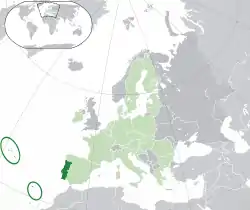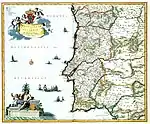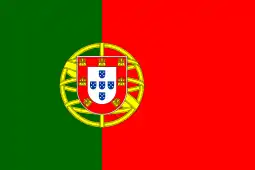Third Portuguese Republic
The Third Portuguese Republic is a period in the history of Portugal corresponding to the current democratic regime installed after the Carnation Revolution of 25 April 1974, that put an end to the paternal autocratic regime of Estado Novo of António de Oliveira Salazar and Marcello Caetano. It was initially characterized by constant instability and was threatened by the possibility of a civil war during the early post-revolutionary years. A new constitution was drafted, censorship was prohibited, free speech declared, political prisoners were released and major Estado Novo institutions were closed. Eventually the country granted independence to its African colonies and begun a process of democratization that led to the accession of Portugal to the EEC (today's European Union) in 1986.
Portuguese Republic | |
|---|---|
 | |
| Capital and largest city | Lisbon 38°46′N 9°9′W |
| Official languages | Portuguese |
| Recognised regional languages | Mirandese[a] |
| Ethnic groups (2011) |
|
| Demonym(s) | Portuguese |
| Government | Unitary semi-presidential constitutional republic |
| Marcelo Rebelo de Sousa | |
| Eduardo Ferro Rodrigues | |
| António Costa | |
| Legislature | Assembly of the Republic |
| Formation | |
| 868 | |
| 1095 | |
| 24 June 1128 | |
• Kingdom | 26 July 1139 |
| 5 October 1143 | |
| 23 May 1179 | |
| 1 December 1640 | |
• Republic | 5 October 1910 |
| 25 April 1974 | |
• Present Constitution[b] | 25 April 1976 |
| 1 January 1986 | |
| Area | |
• Total | 92,212[1] km2 (35,603 sq mi) (111th) |
• Water (%) | 0.5 |
| Population | |
• 2015 estimate | 10,341,330[2] (83rd) |
• 2011 census | 10,562,178[3] |
• Density | 115/km2 (297.8/sq mi) (97th) |
| GDP (PPP) | 2017 estimate |
• Total | $306.762 billion[4] (50th) |
• Per capita | $29,422[4] (40th) |
| GDP (nominal) | 2017 estimate |
• Total | $213.001 billion[4] (43rd) |
• Per capita | $20,429[4] (36th) |
| Gini (2013) | medium |
| HDI (2015) | very high · 41st |
| Currency | Euro (€)[c] (EUR) |
| Time zone | UTC−1 (WET/GMT (UTC) AZOT) |
| WEST (UTC+1) AZOST | |
| Note: Mainland Portugal and Madeira use WET/WEST, the Azores use AZOT/AZOST | |
| Antipodes | New Zealand and Pacific Ocean |
| Date format | dd/mm/yyyy |
| Driving side | right |
| Calling code | +351 |
| ISO 3166 code | PT |
| Internet TLD | .pt |
| |
Part of a series on the |
|---|
| History of Portugal |
 |
| Timeline |
|
|
Background

In Portugal, 1926 marked the end of the First Republic, in a military coup that established an authoritarian government called Estado Novo, that was led by António de Oliveira Salazar until 1968, when he was forced to step down due to health problems. Salazar was succeeded by Marcelo Caetano. The government faced many internal and external problems, including the Portuguese Colonial War.
On 25 April 1974 a mostly bloodless coup of young military personnel forced Marcelo Caetano to step down. Most of the population of the country soon supported this uprising. It was called the Carnation Revolution because of the use of the carnation on soldiers' rifles as a symbol of peace. This revolution was the beginning of the Portuguese Third Republic. The days after the revolution saw widespread celebration for the end of 48 years of dictatorship and soon exiled politicians like Álvaro Cunhal and Mário Soares returned to the country for the celebration of May Day, in what became a symbol of the country's regained freedom.
After the revolution
After the fall of the Estado Novo, differences began to emerge on which political direction the country should take, including among the military. The revolution was mainly the result of the work of a group of young officers unified under the Movimento das Forças Armadas (MFA). Within this group, there were several different political views, among them those represented by Otelo Saraiva de Carvalho and considered to be the more radical wing of the movement and those represented by Ernesto Melo Antunes, considered to be the more moderate one.
In addition to that, to ensure the success of the uprising, the MFA looked for support among the conservative sections of the military that had been disaffected with the Caetano government, chief among which were the former Head of the Armed Forces, General Francisco da Costa Gomes, and General António de Spínola. Both had been expelled from the Estado-Maior-General das Forças Armadas for criticizing the government.
The differing political views came to be broadly represented by three main informal groups, which included both military and civilians. However, even within these groups that shared similar political views there were considerable disagreements.
- the conservatives: within the military, represented by Costa Gomes and Spínola and within the MFA by Melo Antunes. Its civilian representatives were politicians that had been part of the Ala Liberal (Liberal Wing) of the Assembleia Nacional (National Assembly) that called for a transition to democracy, among them the future Prime-Ministers Francisco de Sá Carneiro and Francisco Pinto Balsemão.
- the socialists: that were in favour of creating a social-democratic state like those of Western Europe and were mainly represented by the Socialist Party and its leader Mário Soares.
- the communists: that were in favour of creating a communist state with an economic system similar to those of the Warsaw Pact countries. The main representative of this group within the military and the MFA was Otelo Saraiva de Carvalho, while the main political party included in this group was the Portuguese Communist Party (PCP), led by Álvaro Cunhal.
2000s
In 2001, António Guterres, the Prime Minister since 1995, resigned after the local elections, and after legislative elections on the following year, José Manuel Barroso was appointed as the new Prime Minister.[9]

Euro 2004
Euro 2004 was held across Portugal. The final match was won by Greece against Portugal. Several new stadia were built or rebuilt for the event. This event granted Portugal an opportunity to show its hosting abilities to the rest of the world.
2006 presidential elections
The Portuguese presidential election were held on 22 January 2006 to elect a successor to the incumbent President Jorge Sampaio, who was prevented from running for a third consecutive term by the Constitution of Portugal. The result was a victory in the first round for Aníbal Cavaco Silva of the Social Democratic Party, the former Prime Minister, who won 50.59 per cent of the vote in the first round, just over the majority required to avoid a runoff election. Voter turnout was 62.60 per cent of eligible voters.
Economic difficulties
From 2007-8 onwards, Portugal was severely affected by the European sovereign-debt crisis. The legacy of considerable borrowing from earlier years became an almost unsustainable debt for the Portuguese economy, bringing the country to the verge of bankruptcy by 2011. This resulted in urgent measures to address structural problems in the economy, raise taxes and reduce public-sector spending. Increasing unemployment also led to increased emigration.
Timeline

See also
- Portuguese films of the 2000s
- Treaties of Portugal
References
- (in Portuguese) Público. "Portugal tem 92.212 quilómetros quadrados, por enquanto...". Retrieved 2 July 2012. Archived 5 October 2012 at the Wayback Machine
- (in Portuguese) . Accessed on 17 June 2015.
- (in Portuguese) Portugal. Censos 2011 Archived 2012-11-27 at the Wayback Machine (ine.pt)
- "Portugal". International Monetary Fund. Retrieved 3 April 2017.
- "Gini coefficient of equivalised disposable income (source: SILC)". Eurostat Data Explorer. Retrieved 13 August 2013.
- "2016 Human Development Report". United Nations Development Programme. 2016. Retrieved 25 March 2017.
- "Reconhecimento oficial de direitos linguísticos da comunidade mirandesa (Official recognition of linguistic rights of the Mirandese community)". Centro de Linguística da Universidade de Lisboa. Archived from the original on 18 March 2002. Retrieved 2 December 2015.
- The Euromosaic study, Mirandese in Portugal, europa.eu – European Commission website. Retrieved January 2007. Link updated December 2015
- Nash, Elizabeth (March 18, 2002). "Right gains power by narrow margin in Portugal". The Independent. Independent Print Limited. Retrieved October 2, 2011.


.png.webp)